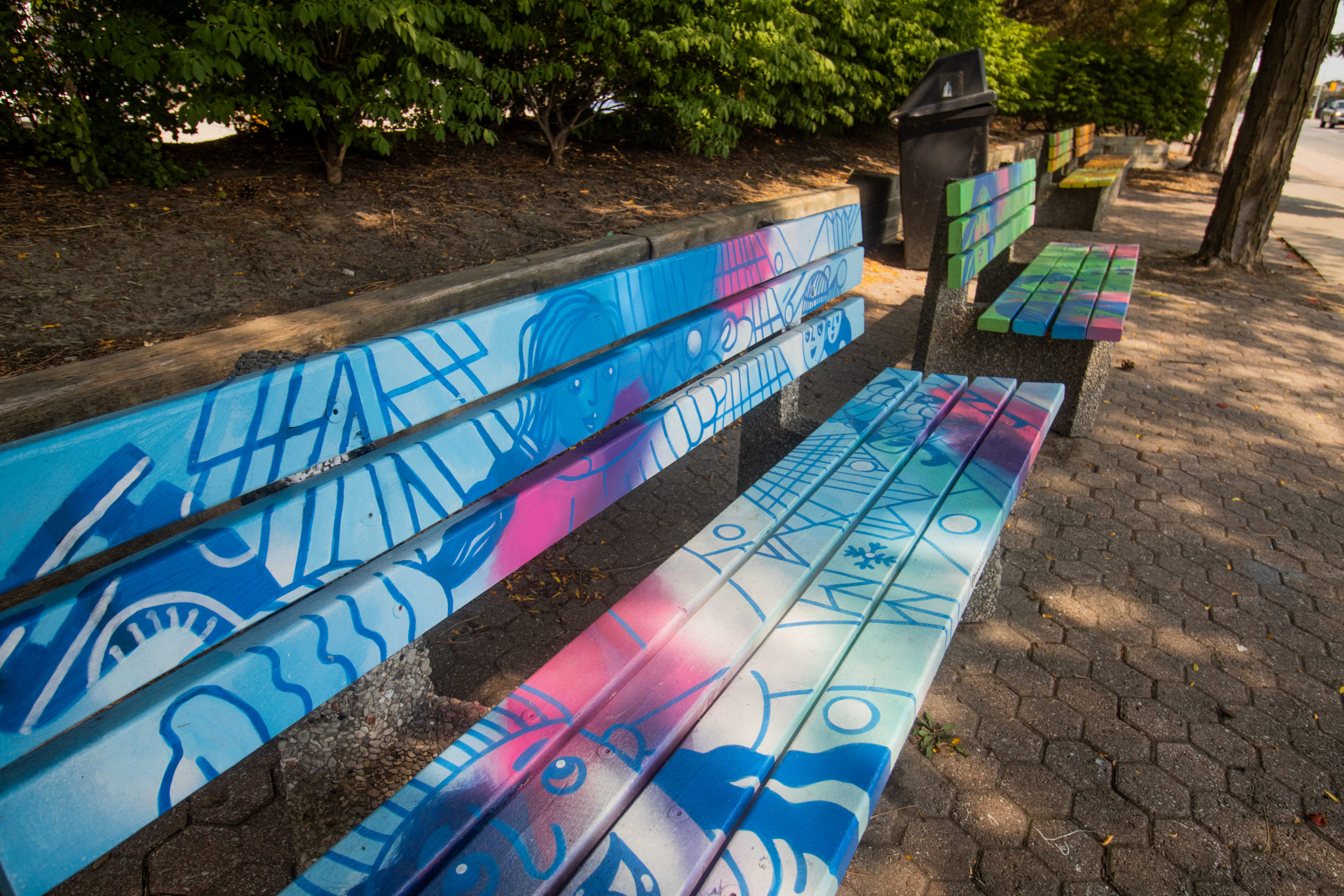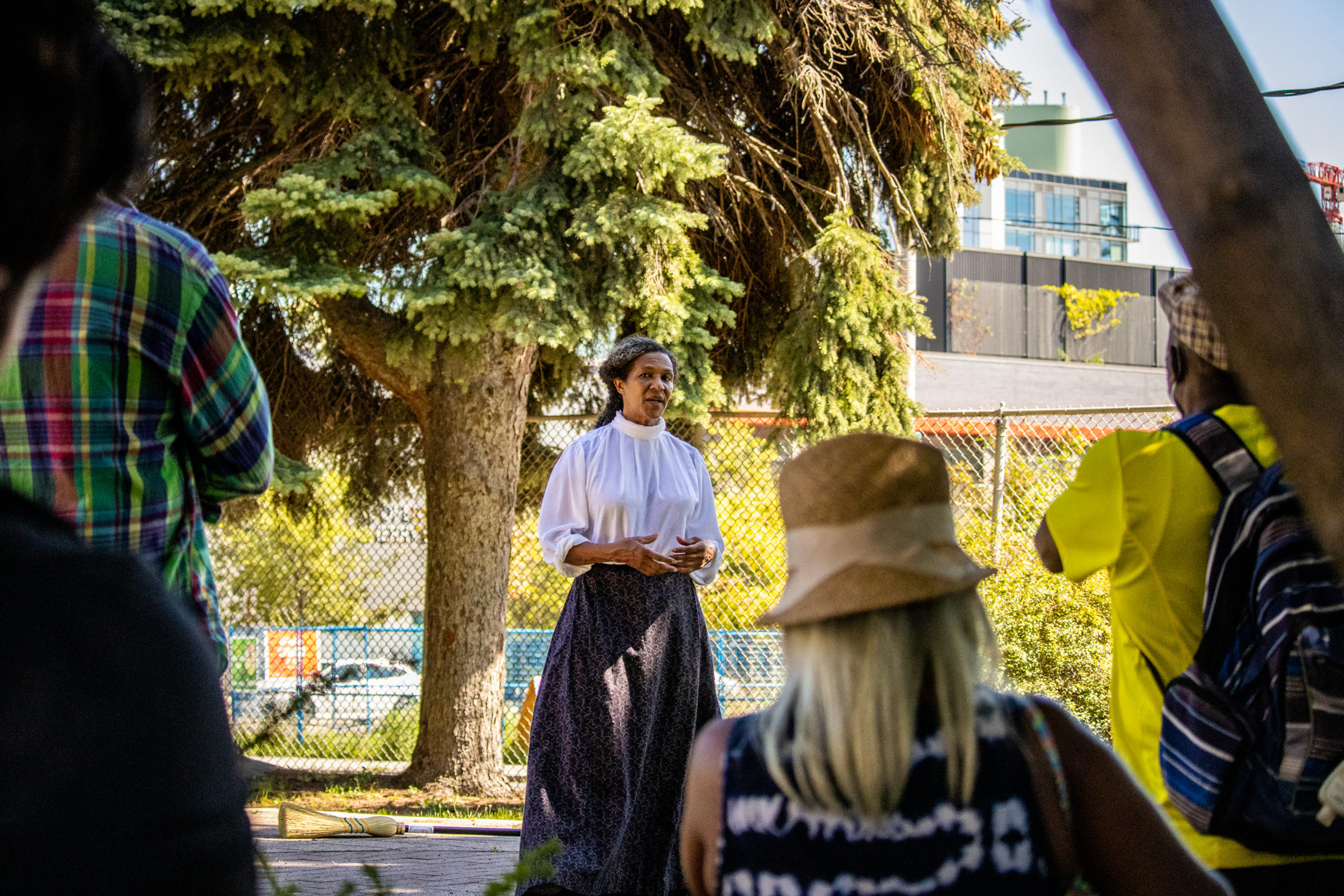What does public art do? Exploring the ways public art can benefit Canadian cities
The idea of “public art” used to be synonymous with large-scale, permanent, physical works, like bronze sculptures of colonial leaders in city centers. This has changed over the last half-century, with efforts to de-colonize spaces and institutional critique that pushed art forms to exist outside of historically exclusive sites like galleries. Now, the term “public art” encompasses a range of perspectives and mediums, making room for creative expressions that exist all around us in new ways; things like ephemeral works, pop-up exhibitions, artistic interventions, performances, or community-led programming.
This expanded definition of public art includes different approaches, production methods, and goals, but essentially all public art aims to make everyday life in the space more dynamic, interesting, or enjoyable. Some public artworks are meant to be functional, while others challenge the traditional functions of a space. Some public art is developed as part of city infrastructure, and some of it evades technocratic systems. As critical frameworks develop around public art practices, they are often categorized as top-down, installations, or grassroots, community-led projects. This blurring of the lines between “consumers” and “producers” of public space is reflected in the growing popularity of community-engaged urbanism and public art.

Small-scale, community-level public artworks are becoming increasingly popular as a tool for main street recovery, like these benches animated by Mahmood Hosseini in Cooksville, Mississauga as part of I HeART Main Street
Photo credit: Selina McCallum
The evolving field of public art allows for exciting new approaches to the complex ways that art can influence and shape city spaces. Increasingly, there is nuanced consideration given to the installation of public artworks; it’s more widely recognized that shared spaces have contradicting uses, layers of history that can’t be simplified, and often cater to certain groups over others. Public art can be a powerful creative placemaking strategy, building on the place identity and reflecting the values of a communal space. When it’s made with these considerations in mind, public art can challenge inequities that exist in public spaces and benefit the population. Because of the evolving scope of public art projects, which is continuing to grow, there is a range of public art benefits and consequences from these different efforts. Public art projects can work as creative placemaking strategies in different ways:
Public art can develop a sense of place and shared civic identity
The idea of “creative placemaking” involves shaping the public realm to represent a sense of place. Public art projects can be a part of this process by illustrating elements of a city’s shared history and reflecting the values that make up a place’s identity. A civic identity brings together a larger geographic community: residents from various social groups can feel a sense of ownership and pride when a monument or public artwork becomes representational of their city. For example, the iconic blue wave sculpture at the Halifax waterfront, designed by artist Donna Hiebert in 1990, came to represent the area, popular with the general population as well as visitors. This type of state-sanctioned, often neutral or apolitical, public art can promote a broad definition of a city or area that allows for an overarching sense of belonging. But it’s also important to recognize the specific communities and divergent meanings that make up a place. Other, more grassroots, public art initiatives can build on the layers of narratives to reflect a sense of place and affirm a multitude of contexts.
Public art can represent multiple identities
Cultivating a sense of place is complex, and involves many considerations, stemming from questions like: what does it mean to spend time in this place? Who is catered to in the development of this space, and are certain groups marginalized here? How do different place identities intersect on this site? Contemporary public art doesn’t have to present one uniform identity; it can celebrate multiple functions of a place and embrace the difference that exists in diverse populations.
Collaborative public art projects can consider the existing communities’ various wants and needs, especially those that were marginalized in Canadian urban development. Moving away from the permanent colonial monuments that represented one authoritative system of thought and cultural background, the notion of public art can be composed of a multitude of projects, ranging in scale, that can address different identities and affirm the multitude of perspectives and lifestyles that intersect in public spaces.
![Bruno Canadien_CreateSpace 2021_Photographed by Jeremy Pavka [6] Public Art Examples: Photo of Bruno Canadien’s mural “Source of Life” it is on a brick building, Bruno is standing in front of it, looking at the camera It features geometric shapes and motifs that form a buffalo - there are colours of pink, green, yellow, and purple on a blue background. Part of the overcast sky is showing on the top right corner.](https://stepspublicart.org/wp-content/uploads/2017/06/Bruno-Canadien_CreateSpace-2021_Photographed-by-Jeremy-Pavka-6.jpg)
2022 CreateSpace Artist-in-Residence Bruno Canadien poses with his Source of Life mural
Photo credit: Jeremy Pavka
In Canada, Indigenous placemaking projects aim to advance truth and reconciliation by representing Indigenous (First Nations, Inuit, and Métis) histories and sovereignty as the original people who occupied the land. Projects like Source of Life, a community mural project led by CreateSpace artist-in-residence Bruno Canadien, integrate Indigenous imagery into public space to consider the ongoing impact of colonization, and the intersection of community members with the land and sky.
Public art can strengthen community
As the subject matter of public artworks has shifted away from colonial representations of authority figures, the way we engage with public art has changed as well. With a traditional statue, the ‘producer’ and the ‘audience’ are clearly defined with separate roles; whereas for many contemporary public art programs, community members become part of the process, instead of just spectators. Many contemporary public art projects emphasize community participation in the design, production, or programming to make art that the neighborhood has an authentic connection to.
The From Weeds We Grow project is an example of public art that puts collective communal knowledge, engagement, and connection first to promote wellness in the Rowntree Mills Park. Since 2020, the program has facilitated workshops, virtual walking tours, recreational activities, art-making events, and performances so that collaborators can share teachings, points of interest, and stories. Resulting in an interactive app that explores the space from an artistic, Indigenous, and community-based lens, this public art project considers the park as a collaboration between the different people and groups who maintain, use, and enjoy the space on a daily basis.
Public art can prompt reflection and promote dialogue
Public artwork with an educational value can spark conversations and critical thought on social issues that are specific to a place. Art activations can explore collective memory linked to a place or use counter-monumentalism to disrupt the national historical narratives. This can be a powerful strategy to challenge the systems in place, and prompt reflection from many different perspectives. In this sense, the strength of public art is that it impacts everyone: in small ways, as we admire the art we pass by on the way to work, and in larger ways, as we reflect on what it means to use that space.
The I Am Lucie, I Am Thornton project by 2021 CreateSpace resident artist Charmaine Lurch addresses the cultural history specific to 19 Sackville Street, Toronto, by commemorating Canadian activists and entrepreneurs Lucie and Thornton Blackburn at their original home. The public art activation celebrates the lived history of the Blackburns, who established the first underground railroad in Canada on the site and developed Toronto’s first taxi company in 1837. Lurch’s public art performance blends cultural memory with the present-day landscape, bringing new life and movement to the historical meaning and public archive of the space.

Charmaine Lurch performing her work for an outdoor audience
Photo credit: Selina McCallum
As our cities, towns, and spaces evolve, so do the types of artistic expressions we develop for them. Canadian public art can help build a place identity that embraces the divergent histories and identities in the space, by moving away from models of monolithic ideologies in public spaces towards more pluralistic representations. Contemporary projects in this vein can engage and connect with local communities, address challenges in public spaces, and meet the population’s needs.
Public art projects across Canada have different points of emphasis, from reflection on political or environmental issues to decorative murals or structures that encourage fun in the everyday. These art projects can function as part of the effort to create more equitable cities and promote welcoming, sustainable, and animated public spaces for everyone. Creative placemaking, public art management, and cultural planning strategies can implement public art installations that transform city spaces across the country to foster a sense of belonging and creativity in our everyday lives.
Why is public art important?
Public art benefits cities in different ways; it can develop a sense of place and shared identity, represent the populations that call the place home, strengthen community ties in the area, and encourage conversations about issues or histories facing the site of public space.
What counts as public art?
Public art has changed rapidly in recent years, with exciting new methods and mediums becoming popular in the field. All kinds of artistic animations count as public art, from temporary seasonal installations like decorated warming stations to construction hoarding exhibits, ephemeral sound works or audio stories like the Interconnected Mural, or public performances like Charmaine Lurche’s project I Am Lucie, I Am Thornton.
Who funds public art?
Public artwork can be funded by federal or provincial government (through Percent-for-Art programs or grants to nonprofit organizations like STEPS), or from contributions from individuals, corporations, and foundations.
About the Writer
This article was written by Eva Morrison (she/her), a writer, curator, and painter based in Montreal. Her work has recently been published by Culture Days, Winnipeg Arts, and FARR Montreal. She received a BFA from Concordia University in 2019, specializing in Art History and Studio Arts.

